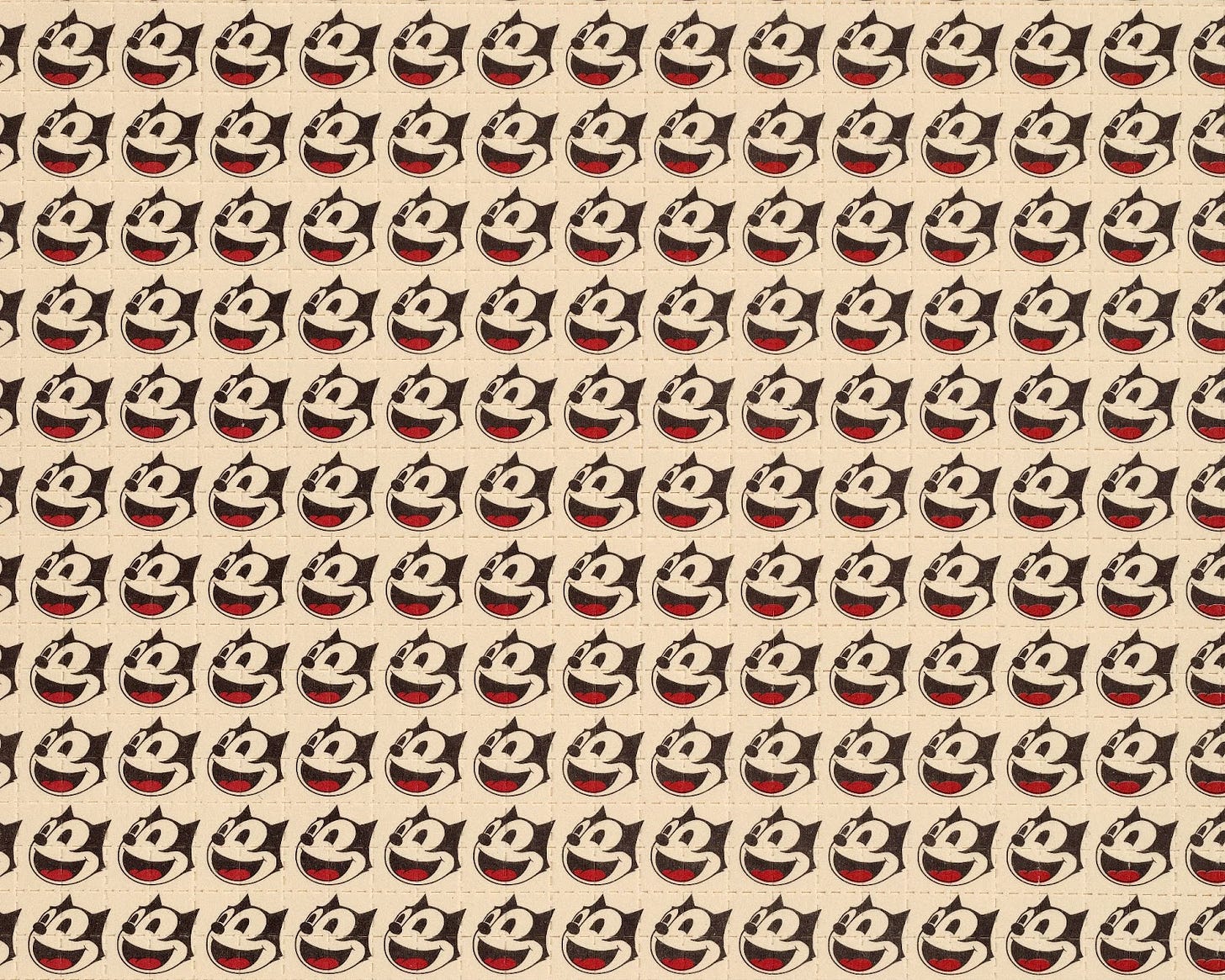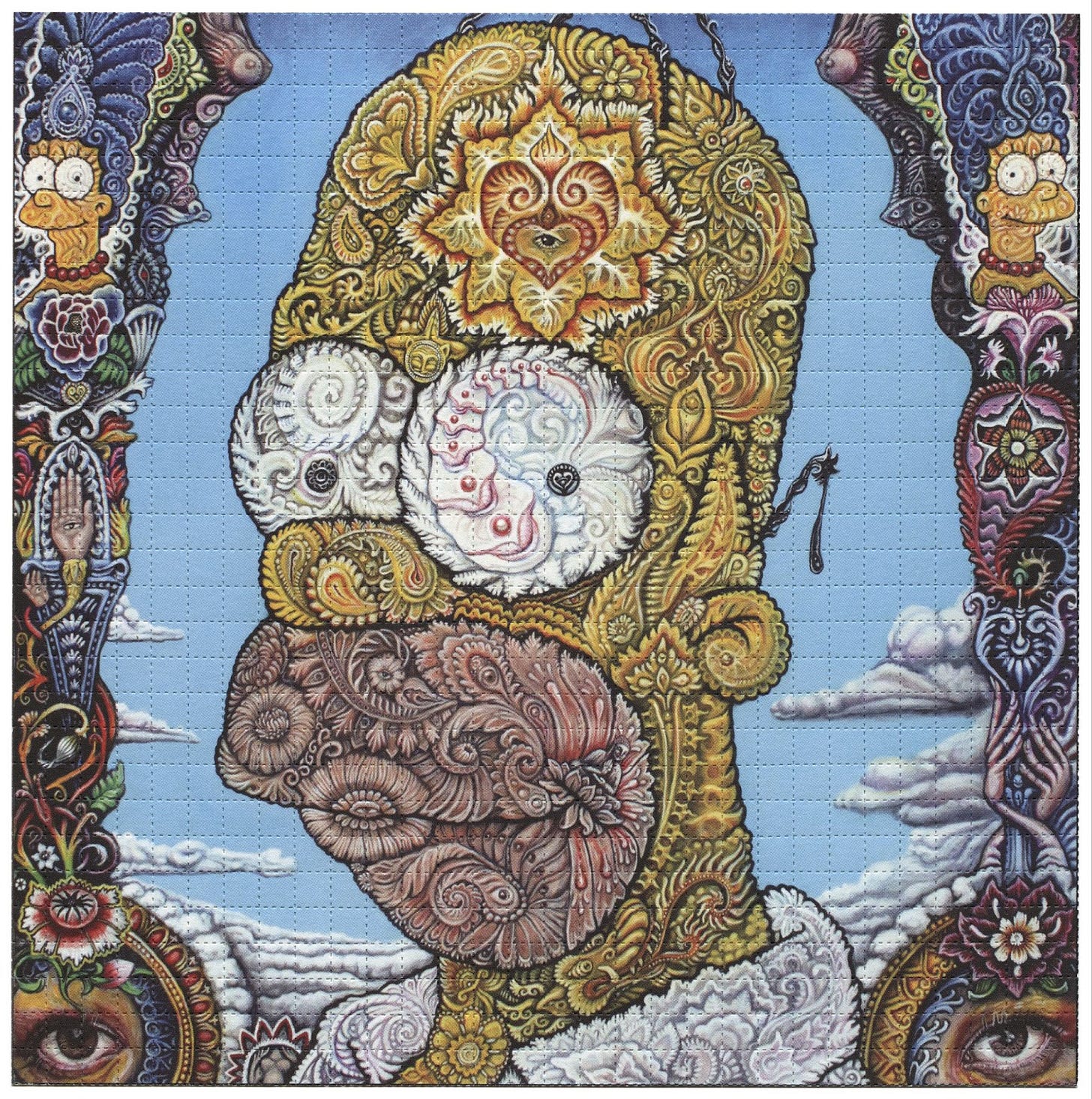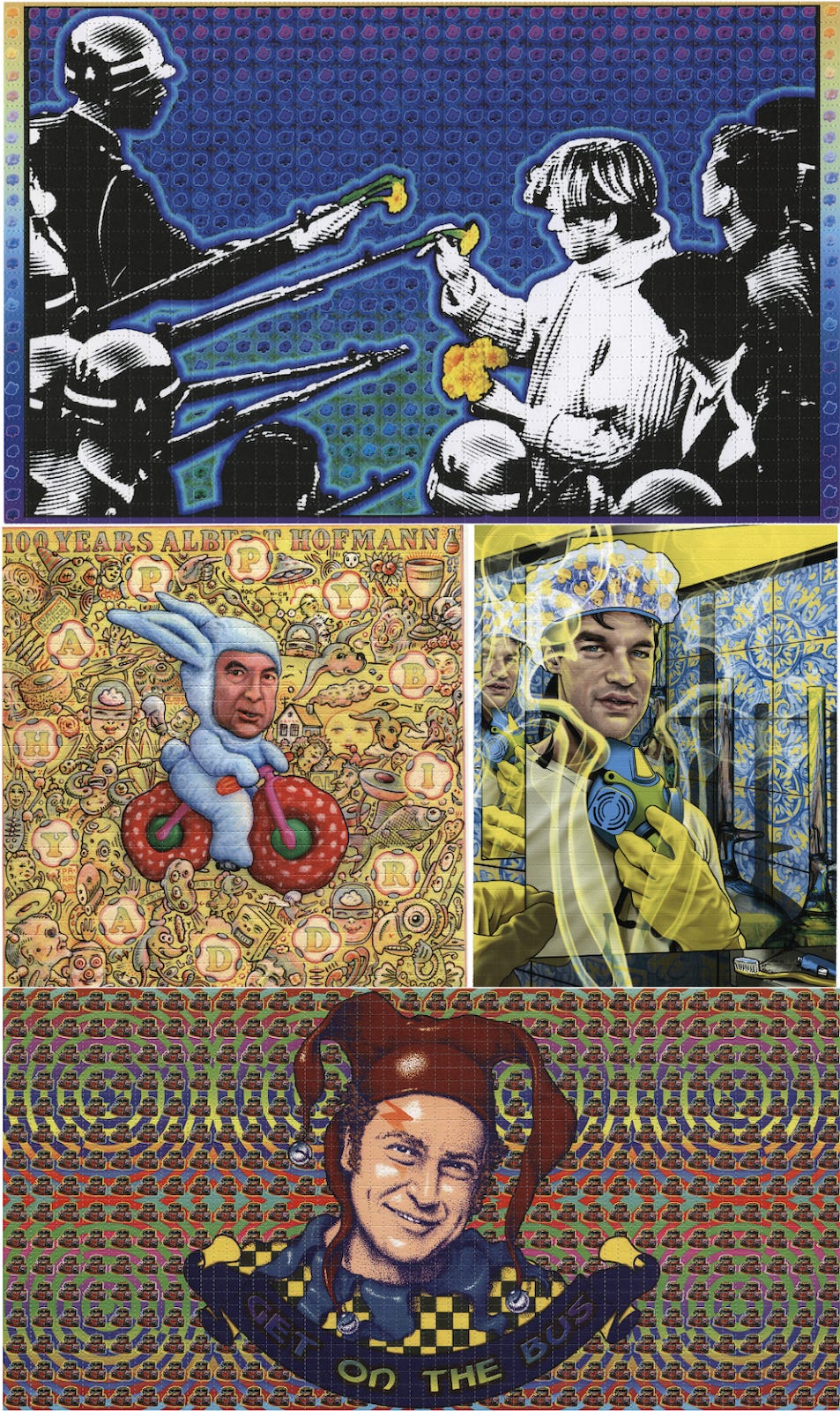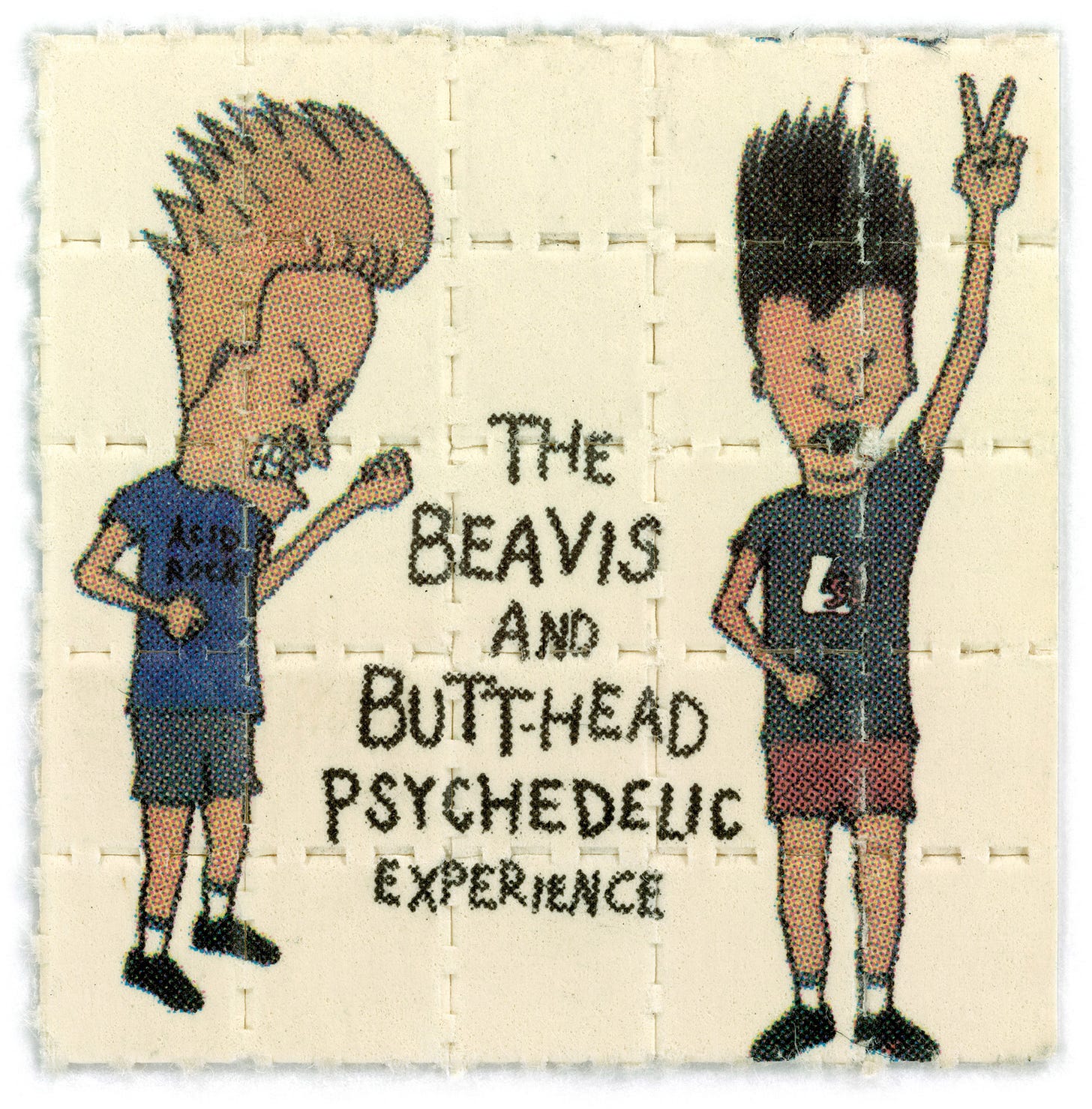Acid blotter paper art: 5 Questions for author Erik Davis
Davis discusses the history of blotter art and how it’s evolved over the last four decades.
Erik Davis grew up in Southern California in the 1970s and 80s. He and his friends were born a bit too late for the psychedelic 1960s, but they managed to do a lot of drugs anyway and were interested in the continuation of that era’s counterculture. They went to Dead shows and read Timothy Leary. After graduating from Yale, Davis wrote about pop culture and counterculture for publications including the Village Voice and Rolling Stone, often with an eye towards what he calls “druggy, weird, freaky stuff.” He’s the author of seven books, including TechGnosis: Myth, Magic and Mysticism in the Age of Information, and High Weirdness: Drugs, Esterica, and Visionary Experience in the Seventies. In April, Davis published Blotter: The Untold Story of an Acid Medium in collaboration with collector Mark McCloud, who has the world’s largest archive of blotter art. Blotter art are the designs printed, hand-stamped, or hand drawn on paper before sheets are dipped in a liquid LSD solution to absorb the drug. A single sheet of blotter paper, typically a 7.5 inch square, is divided into hundreds of pinky-nail sized squares for distribution, which users dissolve on their tongues. The Microdose spoke with Davis about the history of blotter art and how it’s evolved over the last four decades.
Before there can be blotter art, there had to be blotter paper. When did blotter paper come to be the medium through which LSD is distributed?
LSD is a funny material because it needs to be on a carrier medium to make it manageable. From the earliest days, there have been different kinds of carrier media: pills or tablets, gels or liquid. Of course, once something's liquid you can put the liquid on everything. Nobody uses sugar cubes anymore, but they were once widely used; you can drip a drop of LSD suspended in solution onto it. In the 60s, people sometimes used paper to hold the drops and to distribute them, because it's a handy medium, easy to hide, and doesn't weigh very much. But, one of the things I found out is that it really wasn't until the middle or the end of the 1970s that blotter paper started to dominate the market. It's really a child of the 70s, and it doesn't really come into its glory days until the 1980s and the 1990s, which makes it interesting as well, because it became an important medium when LSD culture was declining.
But here’s the thing: you don't need to put images on blotter paper for them to serve as delivery devices. In fact, throughout the whole history of the genre, people have wanted to make and buy blank blotter. You don’t need the pictures. There's something superfluous about the images, which make them even more interesting.

If blotter art is superfluous, what purpose does it serve? What themes come up in the art?
Sometimes the images are badges of identity. Sometimes they're jokes. Sometimes they're like magical glyphs. Sometimes they're almost like prayers or religious icons.
One obvious big category of art would be cartoon characters, like Mickey Mouse, Batman, or other superheroes. Animated and cartoon characters make really good mascots for LSD; on some level it's an easy, fun kind of appropriation. But I think there's something about the appeal of a childlike view of the world, and mischievously playing with that idea given the tension between this mature and highly illegal substance and the goofiness of cartoon characters. Plus, acid does give everything a sense of animation; on LSD, you can look around at an ordinary cityscape and suddenly it's animated, or the front grill of a car becomes a cartoon-like face.

Another category of blotter art, which I did not expect at all, is animals. Mythical animals, cartoon animals, doves, frogs, birds, dragons, rodents, snakes. And I think that’s because animals are the most intimate alien minds that we know; they pull us out of our overly civilized, neurotic minds and into a childlike state. They're alternative forms of consciousness that we can relate to; they become mascots or avatars or guides into other ways of being in the world.
And because blotter really took off in late 70s and early 80s, there’s a lot of punk rock energy, but they’re not necessarily of punk rock, although there are a few homages to hardcore bands of the time. It’s more of a sarcastic energy, like acid has like McDonald's golden arches on it, or the FBI logo — snarky punky, which challenges stereotypes, given the way people think about hippie psychedelia as being kind of love and flowers and unicorns.
Have the artistic themes that you see on blotter paper changed over time?
One major change that has happened is the rise of vanity blotter. Around the year 2000, people started printing blotters that were designed not to be dipped in LSD, but to be collectible artifacts, the way you'd collect a rock poster. Artists would even sign the pieces, since they were destined for people’s walls or collections, not for the street. Most blotter now is more vanity blotter, although of course some of it you can still use to dip, so it has an interesting relationship with the underground and black market. In some sense it’s still technically paraphernalia, but it's created a different visual world. As a result, some people started to reflect on LSD culture itself, so you'd start to see images that were memorializing aspects of LSD culture itself. There have always been goofy things on blotter art like Albert Hofmann or maybe Ken Kesey, but now we’ve got portraits of Nick Sand, the chemist behind Orange Sunshine LSD, memories of Dock Ellis, who in 1970 pitched a no hitter on LSD for the Pittsburgh Pirates. Vanity blotter has become a way of remembering and reconstructing acid history.

What constraints are there in printing on blotter paper, and has that influenced artistic designs at all?
There are some kinds of paper that make it harder to soak with LSD liquid, so actual blotting paper hasn't been used for decades because you don't need something that absorbent. Now many people use paper that’s a bit more like cardstock. Some inks will reject the LSD, but there's a way to fix the inks so they can withstand their encounter with the LSD. There’s also the question of how much ink you want on the paper; inks can be toxic, and you’re ingesting them, so over time there's been a tendency for people to prefer lighter images because it's just less ink. Vanity blotters, on the other hand, are often very thickly inked designs, and they wouldn't be appropriate as actual blotter paper. Some of them wouldn't even work to dip.
How does blotter art get made? Does an artist sell their work to an LSD manufacturer, or does an LSD manufacturer commission art? Or is it more a collaboration?
It was actually very interesting to learn about this from Mark McCloud, who worked in the trade. He didn't just collect; he ended up making blotter for the underground in the 1990s. By talking to other blotter makers, I learned that there were a lot of different ways this happened. Sometimes the manufacturers, the so-called LSD “families”, would distribute the drug and paper together. Sometimes dealers would just buy crystal and say, hey, I want to put this on paper, and they would just use hand stamps that you'd buy in a craft store. Their designs came in small, limited runs. And then a lot of the time, blotter makers were more like independent operators; they had their task to do, and there were different families or dealers that they worked with.
Usually, it was easier for everyone to have the blotter makers be somewhat separate. Organizationally, acid families often keep everyone in the dark a bit so that not everybody knows enough to drag everybody else down if someone is caught by law enforcement. So some blotter artists were very clear that they had nothing to do with laying the LSD down on the paper: they made the paper and they would send it on down the distribution line or sell it to the dealers or distributors. Others started to get kind of more woven into the different distribution networks, but in some ways they were independent actors who were coming up with their own designs or regulars would suggest designs. An artist might ask them what they want. That happened with Mark, who knew a guy named Mike who was a supplier to the Grateful Dead world. Mark went up to him and he was like, “Hey, you want an image?” He thought it would be like a Grateful Dead theme, like a skeleton, but Mike wanted Beavis and Butthead. It wasn’t really Mark’s thing, but he was like, well, Mike wants it, so there was a whole run of Beavis and Butthead blotter paper.

In writing this book, did you come across any favorite designs?
So I mentioned that sometimes dealers might hand stamp paper. Usually if you got sheets that had hand stamps on them, you knew that it was probably a fairly low level source: a local dealer, somebody who wasn't a big operation. If you’re a bigger operation, you're not going to use a hand stamp, you're going to use offset printing; the thing about offset printing is you need to print a minimum number of pieces of paper for it to be economically viable. [Reporter’s note: Offset printers are commonly used for large runs of magazines, newspapers, fliers, manuals, and general bulk printing.] So if you just need a couple sheets, you're not going to do offset printing. You're going to do a hand stamp or even draw it. So there was a run of tigers out of Santa Cruz; the manufacturer was pretty large, and he printed using offset printing but he printed the images of the tigers so that they resembled hand stamps. They're kind of blurry and they're a little bit offset, so if cops came across it, they might be thrown off. I just found that to be very clever and very charming.
This interview has been edited and condensed for clarity and length.







